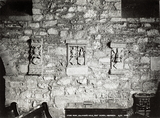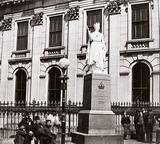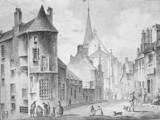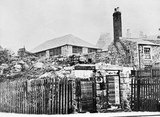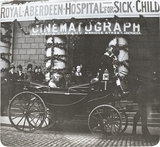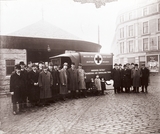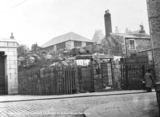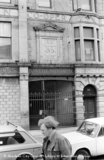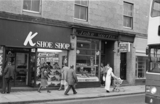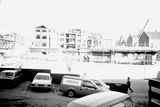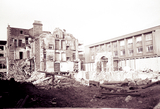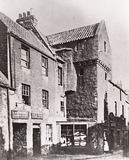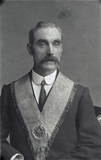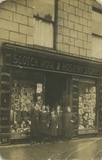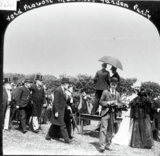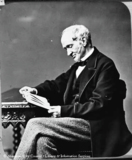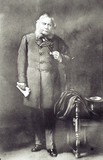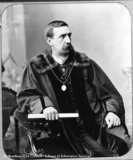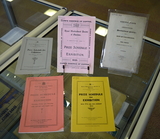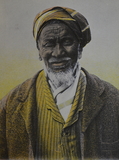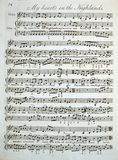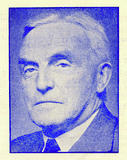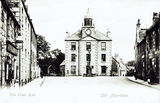|
Quick Search
|
Search Results
You searched for: More Like: 'Civic Society commendation'
171 items
items as
Collison's Aisle, St Nicholas Church
46 This George Washington Wilson photograph shows the memorial stones inserted in the west wall of Collison's Aisle. Originally called Aisle of the Holy Blood, it formed part of the north transept between the East and West Churches of St. Nicholas and was renamed after 1594, although it probably dates from the 14th century. Members of the Collison family held important civic offices at various times, including Provost in 1521 and 1594, and their place of burial was in this aisle. The memorial stones commemerate Andrew Cullen, Thomas Menzies and his wife Mariene Reid, and Sir John Rutherford. Andrew Cullen was a merchant and Provost of Aberdeen in 1506 and 1535, and the stone shows a sculptered coat of arms above the words "Andrew Cullen Prepositus Abd". Thomas Menzies was Provost in 1525 and (for 40 of the next 50 years), only leaving office in favour of other members of his family. He married Mariane Reid of Pitfodels. The stone has two panels above a shield bearing the Menzies coat of arms, flanked by the initials T.M. The second panel has the initials M.R. and a shield with the Menzies and Reid coats of arms. Beneath is the motto 'Spero in Deo et ipse faciet' - Trust in God and he will perform'. The third stone commemorates Sir John Rutherford of Tarland, first elected Provost of Aberdeen in 1483 and every alternate year until 1492, and again between 1496-1500. He probably died about 1520. Statue of Queen Victoria
73 A photograph showing the statue of Queen Victoria at the junction of Union Street and St. Nicholas Street. The building in the background is the Clydesdale Bank that stands next to M&S today. This fine Italian renaissance style building was originally constructed for the Town and County Bank and opened for business in May 1863.
The statue of Queen Victoria was made from marble and was sculpted by Banff born Alexander Brodie (c.1829 - 1867). The origin of this statue is closely related to another Aberdeen monument, the 1863 memorial statue of Prince Albert by Baron Marochetti, now standing, or rather sitting, in the area in front of the Central Library.
Marochetti's statue was augurated by Queen Victoria herself on 13th October 1863 and this was said to the first time the Queen had appeared at a public demonstration following the death of Albert in 1861. The Marochetti statue was the subject of great local controversy and there were various plans for an alternative, superior, memorial to the late Prince Consort. It was at a related meeting that a chap called Alexander Donald, from the Royal Tradesman of Aberdeen, moved "That a colossal statue in marble, of Her Majesty, be erected at the corner of St. Nicholas Street."
The endeavour was taken on by a variety of prominent citizens and funding was raised by public subscription. Brodie, the selected sculptor, worked on an 11-ton block of Sicilian marble for two years to complete the statue. The finished piece is 8 foot 6 inches in height and, at the request of Queen herself, depicts Victoria in Scottish regal attire. The statue stands on a substantial plinth of pink Peterhead granite.
The statue was unveiled and inaugurated on 20th September 1866 by Albert-Edward Prince of Wales, later to be King Edward VII and the subject of another of Aberdeen's notable statues. During his speech at the ceremony, the Prince said "Gentlemen, it has afforded me the greatest satisfaction to attend here today, by the wish of Her Majesty, and at your invitation, for the purpose of inaugurating a statue of the Queen, my dear mother. Her Majesty has desired me to express to you how much she appreciates the motives which have led the people of Aberdeenshire to give this lasting evidence of their attachment and loyalty to her person, of which she has so many proofs, and whose sympathy in her great sorrow has touched her so deeply."
During his visit, the Prince of Wales also received the Freedom of the City and attended the Royal Horticultural Society's Autumn Show, which was then going on in the Music Hall. An extensive account of the unveiling, the Royal visit and the town's celebrations is given in the Aberdeen Journal of 26th September 1866.
After some time at this location, the statue's marble began to show weathering due to the frost and so it was moved to the vestibule of the Town House in 1888, where it remains to this day. It stands at the foot of the building's splendid main stairway. The plaster model of Brodie's statue has also been on display in the Music Hall for many years.
A new bronze statue of an older Victoria, by sculptor Charles Bell Birch, was erected at the St. Nicholas Street location on 9th November 1893 and "the Queen" became a regular meeting place for generations of Aberdonians. To make way for the extension of Marks & Spencer, the 1893 statue moved to its current site at Queen's Cross on 22nd January 1964. Victoria now stands looking east towards Balmoral. Wallace Tower, Netherkirkgate
103 Wallace Tower in the Netherkirkgate looking towards St. Nicholas Church. The tower never had any connection with William Wallace. It is believed to have been the town residence of Sir Robert Keith of Benholm. The name "Wallace" may have been a corruption of "well-house". The Wallace Tower was re-sited at Tillydrone in the 1960s.
Correspondent Ed Fowler suggests that the ornamental building shown on the left at the end of the Netherhirkgate, next to the horse and cart, is the Dyers' Hall.
The name refers to the Dyers' or Litsters Society who were once an important and wealthy industrial group in Aberdeen. Newspaper notices suggest the building was used as a public house, where societies regularly met, and that it, and other buildings, were demolished in around 1807 to make way for a new street between Union Street and Tannery Street. Site of Mar's Castle
108 Site of Mar's Castle, Gallowgate after its demolition in 1897. The building in the background was for many years the meeting place of the Society of Friends (Quakers). They also had a burial ground in this area in the 1670s. The building was acquired by John Watt and Sons, leather merchants. The upper part had louvre windows which made it suitable for drying leather.
The two doorways that remain standing in the centre of the image were part of the tenement located just north of Mar's Castle. Above the one on the left can be seen a sign indicating that this was once the pend leading to Logan's Court. In the late 19th century the address of this tenement would have been 150 Gallowgate.
The demolition of Mar's Castle, and likely this tenement too, began in January 1897. The Town Council bought the property and ordered its demolition so that the street could be widened. Royal visit by Princess Beatrice
315 A photograph showing Princess Beatrice at Aberdeen Music Hall to open a bazaar in aid of the Sick Children's Hospital.
The bazaar took place in the Music Hall on Saturday 29th and Sunday 30th October 1898. Princess Beatrice, then known as Princess Henry of Battenberg, opened the bazaar the day before on Friday 28th October.
The opening ceremony was covered in the Aberdeen Journal of 29th October 1898, page 5. The article states that Beatrice arrived by train at the Joint Station before travelling to the Music Hall from Guild Street by the horse drawn carriage that we can see here.
The route travelled and much of the surrounding area were specially decorated for the occasion. The various businesses and buildings along the route decorated their own premises and many of these decorations are described in the newspaper report.
The city gardeners Peter Harper of Duthie Park and Robert Walker of Victoria Park were tasked with creating floral displays. Harper decorated the interior of the Joint Station and the Music Hall, while Walker decorated the route between the two.
The special royal train arrived at the joint station a couple of minutes before its scheduled time of 12:15pm. Beatrice was greeted at the station by a large civic and military reception and crowds of onlookers.
The newspaper report indicates that travelling in the horse drawn carriage with Beatrice was Miss Minnie Cochrane and Lord William Cecil, both were royal courtiers. The man sat in the carriage is therefore most likely the latter.
Following the opening ceremony, Beatrice was entertained at a luncheon at the Palace Hotel by the directors of the Royal Aberdeen Hospital for Sick Children.
Beatrice and her party returned to Balmoral on a train leaving the station at 2:45pm.
The newspaper also tells us that Messrs. Walker & Company, cinematographers, Bridge Street, filmed the procession as it passed along the railway bridge on Guild Street. Assistant photographers with still cameras captured the rest of proceedings. This photograph was likely taken by one of these assistants.
A sign for Walker & Company can be seen hanging above the Music Hall entrance. This dates the image as belonging to this later royal visit by Princess Beatrice. She previously visited the city on 27th September 1883 to open an earlier bazaar for the Children's Hospital and to open the newly created Duthie Park Red Cross Ambulance
364 A photograph from the presentation of a new ambulance by Aberdeen District engineering and shipbuilding firms to the Scottish Branch of the Red Cross Society on Monday 29th January 1917.
The vehicle, funded by subscription, was for use in Aberdeen and was handed over to Colonel J. Scott Riddell, the Red Cross Commissar. He can be seen fourth from the left in the group on the right.
The leftmost figure of that grouping is Lord Provost James Taggart. He presided over the presentation event that took place in the Red Cross Transport Headquarters on Holburn Street, visible here in the background. Taggart was a granite sculptor by trade and had a works nearby at 92 Great Western Road.
The location of this photograph is at the junction of Justice Mill and Holburn Street. A branch of the Summerhill Farm Dairy is visible in the background.
An account of the presentation and a list of subscribers can be read on page 3 of The Aberdeen Daily Journal for 22nd January 1917. Quaker Meeting House, Gallowgate
765 Site of Mar's Castle, Gallowgate after its demolition in 1897. The building in the background was for many years the meeting place of the Society of Friends (Quakers). They also had a burial ground in this area in the 1670s. The building was acquired by John Watt and Sons, leather merchants. The upper part had louvre windows which made it suitable for drying leather.
The two doorways that remain standing in the centre of the image were part of the tenement located just north of Mar's Castle. Above the one on the left can be seen a sign indicating that this was once the pend leading to Logan's Court. In the late 19th century the address of this tenement would have been 150 Gallowgate.
The demolition of Mar's Castle, and likely this tenement too, began in January 1897. The Town Council bought the property and ordered its demolition so that the street could be widened.
This photograph was taken at the junction with Innes Street and looks east across Gallowgate. The Northern Co-operative Society building, Loch Street
1190 The Northern Co-operative Society (Norco) opened for business in a small shop in the Gallowgate in 1861, and in 1905 these larger premises became their HQ. By 1920, their name had been changed to the Northern Co-Operative Society. The building covered an extensive area between the Gallowgate and Loch Street, and this photo shows the Loch Street entrance to the Arcade which gave access through the building and to the Gallowgate. The 'Coopie' provided many people with all their requirements supplying clothes, shoes, groceries, milk, meat and coal. When the NCS opened their new HQ in Norco House in 1970, this building was vacated and stood empty until it was demolished as part of the redevelopment of the area for the Bon-Accord Centre. George Street
1193 This 1987 photo of the west side of George Street shows nos. 29 and 31 in their last days of trading before closing prior to their demolition for the shopping development to be known as the Bon Accord Centre.
John Martin, butcher, had been in business here for nearly 100 years. The original John Martin opened this shop after having been manager in the butchery department of the Northern Co-operative Society. He retired in 1932 and the business was carried on in the same name by his two sons. On the door was the sign: "Redevelopment closure - this shop will cease trading Saturday 11 April 1987".
Sometime prior to the demolition of the building, the flats above these shops had been renovated as accommodation for students at Robert Gordon's Institute of Technology (now The Robert Gordon University). Demolition of Norco building
1209 Demolition of Northern Co-operative Society (Norco) building in Loch Street prior to building of Bon Accord Centre. Greyfriars House in the Gallowgate is in the background. Demolition of Norco building
1210 Demolition of Northern Co-operative Society (Norco) building in Loch Street prior to building of Bon Accord Centre. Greyfriars House in the Gallowgate is in the background. Mar's Castle
1279 Mar's Castle which stood on the East side of the Gallowgate, opposite Innes Street. It is said to have been built by the Earl of Mar as his town lodging. A burial ground and meeting house for the Society of Friends lay next to the 'castle'. Declared unfit for habitation, it was acquired by Aberdeen Town Council and demolished 1897. During demolition the date 1595 was found on the gable. Free Gardener
1659 Photographic portrait of a man wearing the sash and medallion of the Order of Free Gardeners.
The Free Gardeners were a friendly society founded in Scotland in the mid-17th century.
Newspaper reports indicate that the Order was considerably active in Aberdeenshire until at least the mid-20th century.
An article in the Press and Journal of 2nd May 1949, page 6, records the address to the North of Scotland district delegation in Aberdeen of the retiring Worthy District Master Charles I. Crighton.
Crighton reports a drop in local membership of the Order, both among the adult and juvenile branches, largely crediting this to the introduction of the National Health Service. The district adult membership stood at 5124, a drop of 110, and a juvenile membership had decreased by 206.
This photograph of an unknown Free Gardener likely dates from the early 20th century. The Hosier
1744 Members of staff stand outside the front of The Hosier shop around 1930. This photograph was lent to Local Studies by a member of the library staff whose mother features in the image.
The shop, owned by Leslie M. Hatt, was at number 90-92 Union Street. The Hosier first appears, among 23 other hosiers, in Aberdeen Directories for the year 1925-26 and continues to feature until the 1960s. In the directory for 1965-66 the shop has moved to premises at 82 Union Street and another store has been opened at 73 Victoria Road. At this point it was one of only three hosiers listed for the whole city. Hatt also owned a menswear shop which in 1926 was located at 116 Union Street.
Hatt was a patriotic, civic minded, and well known fellow. He was involved in Aberdeen's YMCA and a captain of The Boys' Brigade. The Press and Journal reports a lecture he gave in the 1930s on the meaning of the Flag and Empire. He was most well known, however, for delivering humorous sketches and recitations. Moreover he and Mrs Leslie Hatt were keen singers and regularly contributed to concerts for worthwhile causes.
In 1928 a young sheep that had spent three or four weeks in the window of The Hosier was sold at auction to raise funds for the Lord Provost's Joint Hospital Fund. After much bidding it was eventually won by a butcher from Great Northern Road, who donated it right back to be auctioned again the next week. Provost Mearns' Garden Party
1926 Those in attendance mill around at Provost Daniel Mearns' garden party. Mearns served as Provost of Aberdeen between (1895-1898) in addition to many other civic roles such as Governor of Robert Gordon's Technical College. Provost John Webster of Edgehill
2042 A portrait of Provost John Webster (1810 - 31st May 1891). He served as Provost of Aberdeen from 1856-1859. He was the son of Alexander Webster, advocate in Aberdeen, and married Margaret Chalmers in 1839. Like his father Webster was a member of the Society of Advocates in Aberdeen. He entered the Town Council in November 1853. Sir Alexander Anderson of Blelack
2044 A portrait of Provost Sir Alexander Anderson (10th June 1802 - 11th April 1887). He served as Provost of Aberdeen from 1859-1866. He was the only son of Alexander Anderson, minister of Strichen, and Helen Findlay. Anderson graduated from Marischal College in 1819 and was admitted to the Society of Advocates in 1827. Later he formed a partnership with William Adam, creating the firm Adam and Anderson which existed until 1867. He entered the Town Council in November 1859. On the 13th October 1863 the Prince Consort's statue at the corner of Union Terrace, later moved to Rosemount Viaduct, was unveiled by Her Majesty and on this occasion Anderson received his knighthood in recognition of his public service. This portrait was painted by Sir George Reid. He and his wife are buried in the graveyard of St Nicholas Church. Baillie Rust
2063 A photographic portrait of Baillie John Rust (1853-1919). He was the son of John Rust and Margaret Henderson. His father founded the well-known timber merchants John Rust & Son in 1845.
John Rust junior was an architect and local politician. He served his architectural apprenticeship with John Russell McKenzie before going into business for himself with offices on Union Street, latterly number 224.
Rust was highly active in local life. He was elected to the Council in 1886 representing the Rubislaw Ward. He was re-elected in 1889 and promoted to the position of Third Ballie in 1890.
On the death of the incumbent, William Smith, Rust was a successful applicant for the post of city architect. On his appointment in March 1892 he retired his place on the Council. He served as city architect until his death in 1919.
Along with Sir Alexander Lyon and John Morgan, the builder, Rust was considered a moving spirit in the local government regime known as the "Young Party".
His Aberdeen Journal obituary highlights his involvement in the Beach Bathing Station scheme and the Union Terrace improvements. Also that he was a justice of the peace for Aberdeen City and Kincardineshire.
Moreover he was a significant property owner and was involved in local political, civic, military and church groups.
He died suddenly while on his way to work from his residence of Hawkshill, Milltimber. He was buried in Nellfield Cemetery. His Aberdeen Journal obituary can be found in the issue for 12th September 1919, page 6.
An entry for John Rust can be found in the Dictionary of Scottish Architects here Treasure 6: Royal Horticultural Society of Aberdeen
2275 Enthusiastic gardeners who have spent months, if not years, nurturing their plants have the opportunity to display their efforts at flower shows - usually held in August or September. These events for individuals happen all around the country and have a long history.
Britain in Bloom is the national flower show for whole communities. It was the brainchild of Roy Hay, a horticultural journalist. Following a holiday in France where he admired the "Fleurissement de France", he persuaded the British Travel and Holidays Association (later the British Tourist Authority) to organise a similar competition for communities in Britain.
Although the first competition in 1964 was won by Bath, Aberdeen received a "Special Mention". The city did even better in 1965 when it won the National Trophy. Although it did not win again until 1969, the city then continued its success each year until 1971. However, this achievement led to Aberdeen being debarred from the National Competition in 1972 although it still won the Scottish section. 1973 and 1974 saw Aberdeen winning the National award again, and its record 10th win was in 1998.
A slogan competition was held for the 1968 campaign when the winning entry proclaimed "Aberdeen - Garden City by the Sea".
In order to celebrate Britain in Bloom and Aberdeen's success in the competition we have chosen to highlight our collection of historic prize schedules for the Royal Horticultural Society of Aberdeen's annual exhibition.
The Aberdeenshire Horticultural Society was founded in March 1824 when a meeting of "Practical Gardeners" was held in the New Inn for the "purpose of forming themselves into a Society". The Earl of Aberdeen graciously agreed to be Patron of the Society.
In November 1863, it was announced at the annual general meeting that HRH the Prince of Wales had now agreed to become Patron of the Society and that the Society's name was to be changed to the Royal Horticultural Society of Aberdeen.
The Society's "Prize Schedule for Exhibition" gives details of each of the classes which can be entered, with the prizes which can be won - a sum of money or a cup or medal. In 1920, there were a total of 222 classes and those who exhibited were split into one of four Divisions - professional gardeners; nurserymen and florists; amateurs and working class.
The Schedules also contain the Rules of Competition, the Constitution of the Society and a list of Subscriptions and Donations received - these include names, addresses and amounts given. Our earliest copies of the booklets cover the period 1920 - 1937, although the file is incomplete.
The Society celebrated its 175th anniversary in 1999. To take a closer look at these, and many other Aberdeen historic documents, visit Aberdeen Central Library. Treasure 32: George Washington Wilson South Africa Photography Collection
2320 George Washington Wilson is one of the great names in 19th century photography, famous for capturing images of people, buildings and landscapes across Scotland. His photography drew attention to the beauty of his country, but his travels further afield are not as well known.
As an innovative pioneer in photography, George Washington Wilson's work reflected the reality and attitudes of society during his lifetime (1823-1893). In our collections we hold a vast selection of photographs and portraits taken by the G. W. Wilson Company in South Africa. These images were taken by his son, Charles Wilson, and Fred Hardie, a company photographer of George Washington Wilson & Co.
The company's photographs of South Africa captured scenes of the country which would have been perceived as unusual and exotic to British people at the time.
South Africa and its Treasures
The majority of British colonization was concentrated in South Africa during the 19th century. In the past, the country was colonized in order to control one of the main trade routes to India. Due to the abundance of resources such as spices and tea, European interest in Africa increased dramatically in the late 19th century, especially with the discovery of gold and diamonds in the 1860s-1880s.
On their return to Britain, George Washington Wilson & Co presented many photographs showing these natural resources, from the Robinson Gold mine in Johannesburg to De Beers Diamond Mines in Kimberley.
Tea was also a very valuable resource, and people in Britain were keen to learn more about its production and its use in South Africa.
Photography and Tourism
The collection held by Aberdeen City Libraries shows local places of interest in South Africa. These photographs capture Cape Town and Johannesburg, two of the biggest cities in the country. Many Europeans emigrated to these cities in the 19th century, due to the discovery of valuable resources in the surrounding area.
With the rapid rise of tourism in this period, George Washington Wilson & Co. looked for new ways to promote and sell their work. Around 1880-1890, they started to commercialize their photography via picture postcards, a relatively new concept in Britain. This new form of media met with huge success as it was easy to write and cheap to send. It soon became the standard way to communicate with friends and family when abroad, a holiday tradition which remains today.
The postcards, in colour and having a standard size, featured many different scenes from South Africa and were viewed as an innovative way to publicize the country - and the works of photographic firms such as George Washington Wilson & Co. Treasure 34: A Selection of Original Scots Songs in Three Parts
2322 Although the union of the Parliaments between Scotland and England had taken place almost a hundred years before, as the 18th century was drawing to a close there was still much fascination regarding the differing cultures. In time, Victorian society would give this fascination a renewed vigour, helped by Queen Victoria's passion for Scotland - including the establishment of Balmoral Castle as her residence North of the border. Before that time though, in the late 1790s, books were produced offering English readers an insight into their neighbours' traditions.
One such book was entitled 'A selection of original Scots songs' edited by Franz Haydn and published between 1790 and 1794. The book is designed to introduce the reader to the music and lyrics of traditional songs in Scotland. Haydn's book reproduced the songs along with corresponding music, and also offered a glossary to help with the more obscure language.
Burns' song 'My Heart's In The Highlands' - more popularly regarded today as a poem - makes an appearance in the selected works by Franz Haydn. With the collected works produced between 1790 - 1794, this was at a time when Burns began to suffer from the illnesses which would eventually end his life just a couple of years later.
Robert Burns
Celebrated across Scotland every year, Robert Burns Day takes place on 25 January and is an opportunity to remember Scotland's Bard and his work. Known the world over as the National Poet of Scotland, Robert Burns (1759 - 1796) was born in Alloway, Ayrshire. Burns' early life was one of balance; he toiled on his family's farm by day, and was taught reading and writing by candlelight at night. He conversed in Scots, while learning passages from English texts to further his studies. Although regarded by history largely as a poet, Burns also composed many songs - perhaps his most famous work 'Auld Lang Syne' being one of the few traditionally remembered in song form. One of our treasures this month celebrates Robert Burns' work and that of many other traditional Scottish musicians. William D. Reid
2405 A photograph of Councillor William D. Reid taken from the programme for the 100th film exhibition of the Aberdeen Film Society in January 1950. Reid took over from G. Martin Gray as the Society's chairman in the late 1930s. Aberdeen Maternity Hospital
2409 A photograph of the new Aberdeen Maternity Hospital buildings at Foresterhill. The Aberdeen Maternity Hospital joined the Joint Hospital Scheme late after encouragement from the Medical Officer of Health, other concerned bodies and public opinion. The hospital's site at Foresterhill was gifted by the University of Aberdeen's Medical School and the Aberdeen Royal Infirmary.
Building of the new maternity hospital began in 1934 after being delayed by a lack of funds. It was opened in 1937 with 32 beds at a cost of £52,000. An extra 8 beds were added in 1939 by means of internal reconstruction and in 1941 an antenatal annexe, built by the Town Council and joined to the Maternity Hospital by a corridor, opened with 28 beds.
For more details on the Aberdeen Maternity Hospital please see 'History of the Aberdeen Joint Hospital Scheme and Site' by N. J. Logie and 'The History of Midwifery in Aberdeen' by G. P. Milne, both in Aberdeen Medico-Chirurgical Society: A Bicentennial History 1789-1989 (1989).
This image comes from the hospital's annual report for 1939. Aberdeen Local Studies hold these reports from 1912 to 1947. The Old Aberdeen Town Hall
2496 A postcard image of Old Aberdeen High Street showing the old Town Hall building.
A shop named James Findlay can be seen on the left at what is now 105 High Street.
Correspondent A. G. Duthie informs us that James Findlay is listed in the Aberdeen Post Office Directory for 1904-05 as a newsagent. This gives us a good indication of the date of the photograph. |



